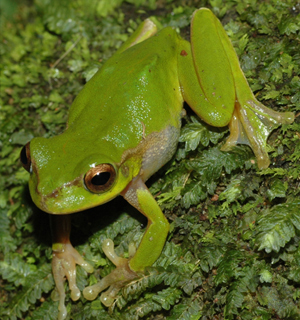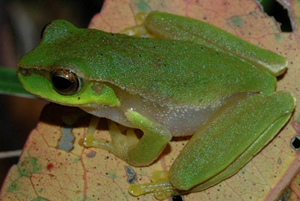Unparalleled diversity of reproductive modes and larval feeding strategies
Today, amphibians, especially frogs, exhibit the greatest diversity of reproductive modes and life-history strategies amongst all terrestrial vertebrates (Gomez-Maestre et al. 2012). All tadpoles grow into frogs, but not all frogs begin as tadpoles. Whereas approximately half of all frog species do start life with eggs laid in water (aquatic breeders), the other half show an extraordinary diversity of other reproductive modes where adult frogs place their eggs not in water but on the land, on leaves, in burrows, in foam nests or even on or inside their bodies — within pouches on their backs or even inside their throats or stomachs — these are classed as the terrestrial breeders. This evolutionary advance may have been driven by the need to escape aquatic predators.
Thus, at the broadest level, frogs can be aquatic or terrestrial breeders (including the direct developers). Finer classifications reflecting progressive trends to terrestrial life styles depend on exactly where eggs are placed, how and where the larvae (if present) feed, and if parental care is involved. Twenty-nine reproductive modes have been identified. There may be more based on recent discoveries in South America. Eight are represented at Springbrook.
The fully aquatic breeding mode (Mode 1) found in over half anuran species is ancestral (both egg laying and larval development entirely within water bodies) and conserved unchanged for several hundred million years. Tadpoles are free-living and do not depend on maternal provisions for food. Preservation of these aquatic breeders is essential because ongoing evolution of terrestrial or direct developing species is mainly possible from aquatic breeding ancestors.
In another group eggs are laid in a terrestrial nest and develop into tadpoles which are free-living but non-feeding (Mode 22) — these are classed as “nidicolous”(Elinson and del Pino 2012). Of the 6,206 species of frogs and toads worldwide, only about 38 species from 22 genera and 7 families have nidicolous larvae. Kyarranus loveridgei, found at Springbrook, is an example.
Assa darlingtoni in the Myobatrichidae is a terrestrial breeder where eggs hatch into nonfeeding tadpoles that finish their development inside skin pouches on the male frog. It is an example of a tadpole stage that is defined as “exoviviparous” (Mode 16).
Remarkably, some hundreds of species have no tadpole stage at all (contrary to what the name “amphibian” implies), instead going directly from egg to froglet. This “direct development” is the ultimate adaptation to terrestrial life. Direct developers represented, for the first time in vertebrate evolutionary history, total independence from water bodies for reproduction. This vital step towards the amniote egg was one of the most significant events in the evolution of terrestrial vertebrates. It set the stage for the evolution of reptiles and the radiation of birds and mammals. Direct development in amphibians has evolved in at least seventeen genera from nine families of anurans worldwide (Thibaudeau and Altig 1999).
There is a clear correlation between adult size and breeding mode. In aquatic breeders females are large and have the advantage of producing very large numbers of small, but unprotected eggs. Amongst direct developers, females tend to be small, producing smaller numbers of large yolk-rich eggs that mostly need to be protected from predators and drying out by either or both adult male and female frogs — it may represent the first beginnings of parental care in vertebrates.
Anuran global biodiversity
Of the three known orders of amphibians, anurans (Anura: frogs and toads) are by far the most diverse (~90% of all amphibians today) and the only order found in Australia.
As a result of the latest molecular tools, the last 10-15 years has seen an explosion in amphibian research so that the number of new families recognized in that period has more than doubled to 54 (Amphibiaweb, 2012). Prior to that, the discovery of new families was once-in-a-century. Many family members today still retain deep evolutionary roots, surviving relatively unchanged in protective ‘refuges’ that resemble their original habitats. Based on evidence from fossils and DNA-based studies, the origins of frogs and toads is considered to be Gondwanan.
Even today, the greatest diversity of anurans remains in the Southern Hemisphere, concentrated in the ‘hottest “hot” spots’ of biodiversity in the world. Close to 60% of all families, 55% of genera and 33% of all species are restricted to the Southern Hemisphere. Only 22% of families, 9% of genera and 11% of species are confined exclusively to the Northern Hemisphere. Many of those straddling both hemispheres are actually considered Gondwanan.
Australian frogs and toads
Of the 6,224 species of frogs and toads recorded worldwide, 237 occur in Australia, equivalent to the numbers found in another globally significant hotspot, Madagascar (Amphibiaweb 2012). By far the highest diversity of native frogs in Australia is in Queensland (122 species/19 genera) followed by New South Wales (83/16), Western Australia (77/14), Northern Territory (48/9), Victoria (36/11), South Australia (28/9), and Tasmania (11/5). The majority of Australian species (57%) occur in the family Myobatrachidae.
The remainder are in the Microhylidae (not yet found at Springbrook but still possible) and the Hylidae. Hylid frogs are the second most species-rich family amongst amphibians with 923 species in 57 genera currently recognized world wide (AmphibiaWeb, 2012). They are mostly arboreal and so known as “treefrogs”. They are most diverse in the old Gondwanic countries — South and Central American tropics and Australia. One of the three subfamilies recognized — the Pelodryadinae — is restricted to Australasia and is basal to the other two subfamilies.
Springbrook anuran species diversity
In the tiny core refugium at Springbrook, there are two families (Myobatrachidae and Hylidae) containing 35 species in 11 genera. As in so many countries, former ranges have contracted greatly either through past climate change or clearing by humans. Rainforests once blanketed the Australian continent but now survive only in refuges amounting to no more than 0.04% of the continental landmass. It is remarkable that, after such losses, Australia harbors so many ancient lineages of plants, fungi, and a wide range of animals, including frogs, such that several areas qualify as World Heritage sites.
The Wet Tropics and the Border Ranges area of South-east Queensland and North-east New South Wales (Slatyer et al. 2007) are the top hotspots of frog diversity and endemism in the country. Both have World Heritage areas, in part because they have the highest rainfall, and topographic and habitat complexity in Australia. These critical environmental attributes helped buffer their precious relict “cargo” against damaging climate extremes over the millennia.
MYOBATRACHIDAE family
Australia is noted for its near endemic family, the Myobatrachidae, an ancient line of frogs that is considered “sister” or “basal” to 70% of all anuran families, 89% of genera and 94% of all frog and toad species. The Myobatrachidae, with 25 species at Springbrook, is made up of two subfamilies: the basalmost Limnodynastinae (10 genera, 66 species), and its sister group the Myobatrichinae, or Australian toadlets (11 genera, 64 species). In some classifications these subfamilies are elevated to family status. Their phylogenetic relationships, based on DNA analyses, are more-or-less resolved. However Frost et al. (2006) identify Kyarranus (Philoria according to some) as basal followed by Adelotus, whilst Professor John Wiens and colleagues (Pyron and Wiens 2011) place them further down in the “tree of life”.
Four out of the 10 genera in the Limnodynastinae subfamily are represented at Springbrook and include Lechriodus (1 species), Adelotus (1), Limnodynastes (6), and Kyarranus (1). Lechriodus and Limnodynastes are entirely aquatic breeders with eggs produced in floating foam nests (Reproductive Mode 8). In Adelotus the male drags fertilized eggs to a foam nest on land which it guards until flooding washes away the tadpoles (Mode 21). Kyarranus is entirely terrestrial and “nidicolous” (Mode 22), whilst Pseudophryne is part terrestrial/part aquatic (Mode 12).
Genera represented at Springbrook in the Myobatrichinae subfamily include Mixophyes (3), Assa (1), Uperoleia (2), Pseudophryne (2) and Crinia (2). Assa is a monotypic genus but Uperoleia (‘toadlets’) is the most species diverse frog genus in the entire Myobatrachidae family with 26 known species. It is considered closely related to Pseudophryne. Whilst Crinia and Uperoleia species are aquatic breeders (Mode 1), Pseudophryne is classed as Mode 12 with eggs and early non-feeding tadpoles developing in an excavated nest until flooding triggers transformation of tadpoles from non-feeding to a feeding mode and disperses the feeding tadpoles into ponds or streams. Assa is a terrestrial breeder but its tadpoles are nonfeeding and complete their development in inguinal pouches (Mode 16). The tadpoles are not typical as they have no spiracle and only vestigial mouthparts and so Assa is considered to be very close to direct developers (Anstis 2010). Mixophyes fleayi is an example of Breeding Mode 3, where eggs and early larval development occur in constructed basins within a stream. M. iteratus and M. fasciolatus both exemplify Breeding Mode 13, where fertilized eggs are transferred out of water onto land in litter, on rocks or undercut banks but tadpoles, on hatching, move to water to feed.
HYLIDAE family
The Hylidae, another Gondwanan family and colloquially known as treefrogs, are the second largest family of amphibians with 924 species in 47 genera (AmphibiaWeb, 2012). Most are arboreal. All Australian hylids occur within the subfamily Pelodryadinae (considered by some scientists as ancestral) which is endemic to the Australasian regions with the highest diversity in Australia and New Guinea. This diversity most likely reflects the rapid changes on the Australian continent as it broke free of Antarctica.
Litoria is the most species-rich genus in the Hylidae family with 198 species (21% of the family). Of these 85 occur in Australia (including the 13 species of Cyclorana and one Nyctimystes species which are now lumped within Litoria).
The Hylidae family is represented at Springbrook by 15 strongly differentiated species of Litoria. The Pelodryadinae subfamily has two major clades (groups) each of which comprise distinct subclades detected by DNA analyses. The 15 Springbrook species have representatives in both major clades. Within five of the 10 subclades of the first clade, Springbrook representatives occur in the rubella (L. dentata), peronii (L. peronii), bicolor (L. fallax), and latopalmata (L. latopalmata, L. nasuta) groups. Within the second clade, Springbrook representatives (L. caerulea, L. gracilenta, L. wilcoxii) occur in three quite evolutionarily distinct subgroups.
MICROHYLIDAE family
The Gondwanic Microhylidae family is not represented at Springbrook, but there are 23 species in northern Australia. Globally, one in 5 frog genera are found within the Microhylidae family (349 species in 67 genera) but they contain only eight percent of the world’s frog species (Van der Meijden 2006). These are low average numbers of species per genus! Twenty-two Microhylid genera are monotypic (only one species in the genus). Microhylids restricted to northern Australia have not been seen at Springbrook. However, given the rate of discoveries amongst amphibians, rare or cryptic species may yet be found, especially if their habitat and landscape connections are allowed to recover.
CONSERVATION STATUS
In just the last two decades extinctions have escalated alarmingly worldwide. Nearly one-third of all amphibians are threatened and 168 species have become extinct globally. Six frog species are missing, presumed extinct in Queensland (2 in the wet tropics, 2 in central Queensland, and 2 in southern Queensland. Rheobatrachus silus, R. vittelinus and Taudactylus diurnus are considered extinct both in the IUCN Red List and under the EPBC Act, but only endangered under the Queensland Nature Conservation (Wildlife) Regulation 2006. Taudactylus acutirostris is considered extinct under the EPBC Act but Endangered under Queensland legislation. Clearly a review of current status is needed. Of the 14 frog species considered as endangered in Queensland two occur at Springbrook (Mixophyes fleayi, M. iteratus). Adelotus brevis is considered Vulnerable. Four of the state’s 12 Near Threatened frogs are found at Springbrook (Assa darlingtoni, Kyarranus loveridgei, Litoria brevipalmata, Litoria revelata). Habitat destruction, alteration and fragmentation are seen as the major causes, followed by non-native species invasions, over-exploitation, climate change, UV-B radiation, pollution and disease. Chytrid fungus is considered to have affect 18 of the threatened, mostly stream-inhabiting species in Queensland (Curtis et al. 2012).
Nearly one third of all amphibians are listed as globally endangered and almost half threatened (compared with just 12% of all bird species). Almost half of all known amphibian species are declining and as many as 168 may already be extinct. In fact a greater proportion of amphibians are at imminent risk of extinction than any other animal class. This is a frightening prognosis for what were the earth’s first terrestrial vertebrates (www.edgeof existence.org).
Many frogs use a variety of habitats during their life cycle for breeding, foraging, hibernation or aestivation. Suitable habitats for all phases of development must be close together and connected otherwise populations will not persist. Unsuitable habitats carry higher risks of predation, disease, desiccation and reproductive failure. Microhabitat quality can be more critical in influencing survival than broad landscape features.
THE FROGS OF SPRINGBROOK
MYOBATRACHIDAE FAMILY (Limnodynastinae subfamily)representatives at Springbrook:
|
Black-soled Frog(Lechriodus fletcheri)
Of the Springbrook species in the Limnodynastinae Lechriodus fletcheri is phylogenetically the oldest. It is the only member of the genus in Australia and is restricted to rainforest and wet sclerophyll forest in southeast Queensland and northeast New South Wales. Remarkably, the only other three species in the genus occur in New Guinea. Such transcontinental disjunctions (if correct) indicate just how much the original habitats have contracted. Fossils of Lechriodus were found at Riversleigh and at Murgon the latter dating to 55 million years ago (the oldest frog fossils recorded anywhere in Australia).
They breed in transient pools, develop very quickly from a floating foam nest, and are capable of cannibalism if external food resources run out.
|
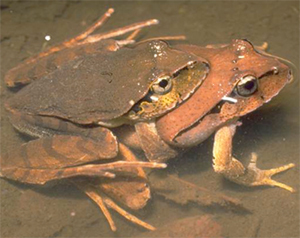
Photo: © Jean-Marc Hero
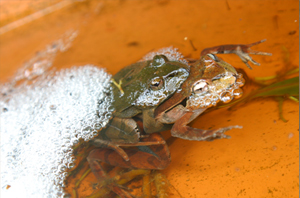
Photo: Mark Ash |
Tusked Frog (Adelotus brevis), another of the oldest species of the Limnodynastinae, probably as old as birds, may have evolved about the same time in the early Cretaceous period more than 100 million years ago. Adelotus brevis is the only survivor in its genus, i.e. it belongs to a monotypic genus and is now threatened over its entire range, being listed as Vulnerable in Queensland and Endangered in New South Wales. It is among those species in the world listed in Amphibiaweb (2012) as examples of parental care in frogs where the male frog drags eggs to a foam nest on land which it guards until heavy rains wash away the tadpoles that rapidly develop after the flooding stimulus (Breeding Mode 21). It is also the only Australian frog species in which the males are larger than the females. They have bony tooth-like tusks, larger in males, where they ‘lock jaws’ in territorial battles with other males. It is now rare to find it above 400 m above sea level with populations continuing to decline (www.edgeofexistence.org, 2012). The New England Tableland population is listed as endangered
|
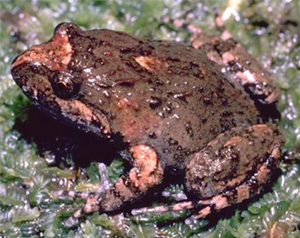 Adelotus brevis
Adelotus brevis Photo: © Jean-Marc Hero |
Masked Mountain Frog (Kyarranus loveridgei)(Philoria) is restricted to high altitudes, generally in areas of soft, moist soils. It is one of two ground-dwelling high altitude frog species at Springbrook not dependent on water bodies for completing their life cycles (Mode 22). It is listed as Near Threatened in Queensland and Endangered in New South Wales. Kyarranus loveridgei is one of our indicator species for recovery of critical habitat in three mountaintop catchments using automatic audio-recorders
|
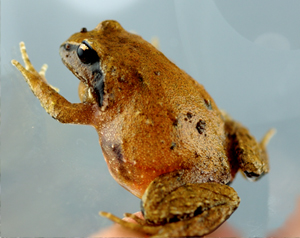 Kyarranus loveridgei (Masked Mountain Frog)
Kyarranus loveridgei (Masked Mountain Frog)
Photo: Aila Keto and Keith Scott |
MYOBATRACHIDAE (Myobatrachinae subfamily) or Barred Frogs represented at Springbrook
Mixophyes is a genus of 8 barred frogs, seven of which are restricted to Australia and one to the southern highlands of New Guinea. They occur in the subfamily Myobatrachinae and are thought to have diverged from other anurans 90 million years ago in the heyday of the dinosaurs. They are not closely related to any other genus, and are basal after Rheobatrachus to all the other extant genera in the subfamily which contains Taudactylus, Spicospina, Uperoleia, Pseudophryne, Myobatrachus, Metacrinia, Paracrinia, Geocrinia, Assa, and Crinia. Three of the seven species of Mixophyes in Australia are either endangered (2) or vulnerable (1). Mixophyes fasciolatus is considered as possibly declining (Murray et al. 2010).
|
Giant Barred Frog(Mixophyes iteratus) is Australia’s largest species of frog and listed as Endangered under state and national legislation. They never move much further away from a stream than 50 meters and are often found half buried under leaf litter, putting them at risk of inadvertent off-track trampling by bushwalkers and other visitors. Their populations are declining and their range is contracting. Populations appear to have disappeared from the Bunya Mountains and Cunningham’s Gap.
|
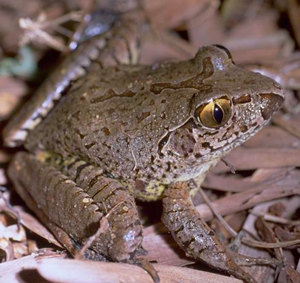 Mixophyes iteratus (Giant Barred Frog) Mixophyes iteratus (Giant Barred Frog)
Photo: © Jean-Marc Hero |
Fleay’s Barred Frog (Mixophyes fleayi) like its closest relative, is restricted to within 50 meters of small streams up to 1000 m above sea level. However, its presence on Springbrook plateau was recorded for the first time in 40 years, early in 2012 independently by Griffith University researchers and ARCS via its network of audio recorders. It is an example of Breeding Mode 3 where eggs and early larval stages occur.
|
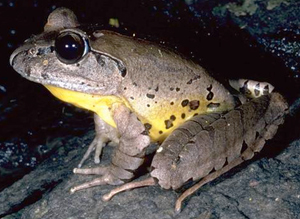
Mixophyes fleayi (Fleay’s Barred Frog)
Photo: © Jean-Marc Hero
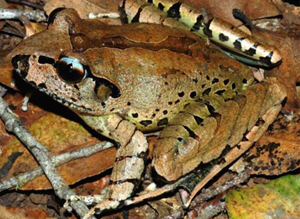
Mixophyes fleayi (Fleay’s Barred Frog)
Photo: froggydarb
|
Great Barred Frog(Mixophyes fasciolatus)
Mixophyes fasciolatus is a large terrestrial frog confined to Australia and more common and widespread than other members of the genus, inhabiting temperate, subtropical and tropical rainforests (including Antarctic Beech forests), and wet eucalypt forests between Eungella in the Clarke Range in mid-eastern Queensland and Gosford in mid-eastern New South Wales. It seems to occur at altitudes between 100 to 1000 m. For breeding it utilizes a variety of water bodies including permanent and intermittent streams, creeks or pools (including artificial waterbodies such as farm dams). After laying its eggs the female tosses them out of the water into the bank to escape predation where the sticky coating on the eggs sticks to litter, rocks and undercut banks overhanging water. Hatchlings fall, wriggle or are flushed back into water by rains. An alternative view is that eggs a laid on land close to water into which the eggs are washed after heavy rain. Females can take up to four years before reaching sexual maturity especially at higher altitudes. The species has recently been predicted to decline in the future (Murray et al. 2010)
|
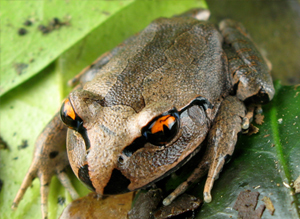 Mixophyes fasciolatus (Great Barred Frog), a juvenile froglet found at high altitudes at Springbrook
Mixophyes fasciolatus (Great Barred Frog), a juvenile froglet found at high altitudes at Springbrook
Photo: Aila Keto |
Red Backed Broodfrog(Pseudophryne coriacea)
This small Australian endemic that is relatively common and widespread belongs to a group of terrestrial frogs that have partially escaped the need for water during their development. Their back is orange red with a broad black stripe on their sides from the snout to the hind legs. The underside is strikingly marbled black and white (www.ozanimals.com). Species within Pseudophryne are called “brood frogs” because some members appear to brood the eggs in a nest. Males call from nest sites in damp soil under leaf litter, grasses or rocks. Tadpoles hatch after heavy rain floods the nest forming temporary pools. Successful metamorphosis is completed before these pools dry up.
|
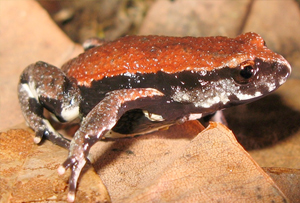 Pseudophryne coriacea (Red Backed Broodfrog)
Pseudophryne coriacea (Red Backed Broodfrog)
Photo: © Harry B. Hines
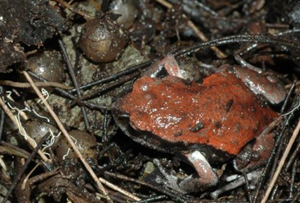 Pseudophryne coriaceae (Red Backed Broodfrog)
Pseudophryne coriaceae (Red Backed Broodfrog)
guarding spawn in terrestrial nest
Photo: Brad (froggydarb)
|
Pouched Frog or Marsupial Frog(Assa darlingtoni)
Assa darlingtoni is a completely terrestrial frog. Both parents guard the nest of eggs and the male then broods the young hatchlings. The female tends the eggs until about 11–12 days old, after which the male climbs into the egg mass, rupturing the capsules. The newly hatched tadpoles climb into the male’s inguinal (around the waist) brood pouches on both sides of its body where they stay until metamorphosis into froglets two months later (Crump 2009). Assa darlingtoni is restricted to the high altitude forests of south-east Queensland and northern New South Wales. It is the only species in the genus Assa.
|
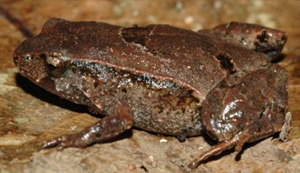 Assa darlingtoni (Pouched Frog)
Assa darlingtoni (Pouched Frog)
Photo: Brad (froggydarb)
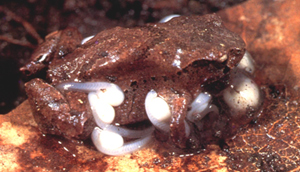 Photo: H. Ehmann
Photo: H. Ehmann |
Members of the HYLIDAE family found at Springbrook |
Rocket Frog(Litoria nasuta)
Frogs move around either by walking, jumping, or hopping. Litoria nasuta can jump the second-longest distance (well over 2 metres) for any anuran, equivalent to over 55 body lengths of an individual. To achieve this remarkable jumping capacity it has the highest published hind limb muscle mass (33% of body mass) of any anuran (James and Wilson 2008).
|
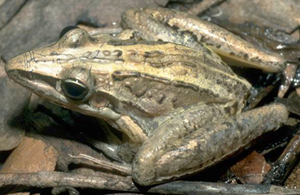 Litoria nasuta (Rocket Frog)
Litoria nasuta (Rocket Frog)
Photo: © Jean-Marc Hero |
Cascade Treefrog(Litoria pearsoniana)
The cascade treefrog belongs to a remarkable, small group (3 species as yet) of “ultrasonic” frogs that can call and hear in the ultrasonic frequency range above 20 kHz. Most frogs communicate using frequencies between 100 Hz and 5–6 kHz. The two other frogs know to have this ability are each in unrelated genera within the Ranidae family from South East Asia. These are the only non-mammalian vertebrate species known to have this ability. It is speculated that this ability evolved in frogs living in extremely noisy, cascade environments in order not to be drowned out by intense, low frequencies in the auditory range. Litoria pearsoniana is a small, stream-breeding frog restricted to the forests of south-east Queensland and north-east New South Wales. It is listed as endangered in Queensland. During the breeding season, adults shelter diurnally under logs, rocks and leaf litter and in moist holes close to a stream. Distinguished Professor Peter Narins from the UCLA Department of Ecology and Evolutionary Biology, was hosted at Springbrook by ARCS early in 2012 to assist his ongoing pioneering investigations into this remarkable frog.
|
|
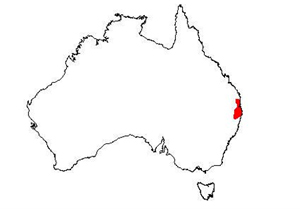
Map prepared by Jean-Marc Hero & Luke Shoo (School of Environmental & Applied Sciences, Griffith University); part of the IUCN Global Amphibian Assessment of Australian Amphibians |
Whirring Treefrog(Litoria revelata)
Litoria revelata has a restricted distribution and listed as Near Threatened in Queensland. It was only discovered as recently as 1982 by Chris Corben and colleagues from nearby O’Reillys on the Lamington Plateau. It exists in three disjunct populations — in the Wet Tropics, Eungella in the Clark Range and from Mt Tamborine in South-east Queensland to Ballina North-east New South Wales. It breeds in still water swamps or ponds in Spring and Summer (Breeding Mode 1). Males are reported to turn a bright yellow during the breeding season, similar to L. wilcoxii. The species has been found on many of the high altitude sites ARCS is restoring at Springbrook. Long-term changes in its populations are being monitored by our autonomous network of audio-recorders.
|
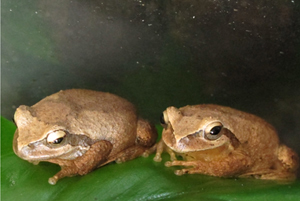 Litoria revelata (Whirring Treefrog)
Litoria revelata (Whirring Treefrog)
Photo: Aila Keto |
| References |
Amphibiaweb (2012) http://amphibiaweb.org
Anstis, M. (2010). A comparative study of divergent embryonic and larval development in the Australian frog genus Geocrinia (Anura: Myobatrichidae). Records of he Western Australian Museum 25, 399-440.
Crump, M.L. (2009). Amphibian diversity and life history. In Amphibian Ecology and Conservation. Ed. C.K. Dodd, Jr. Oxford University Press. 588pp.
Curtis, K., Dennis, A.J., McDonald, K.R., Kyne, P.M. and Debus, S.J.S. (2012). Queensland’s Threatened Animals. CSIRO Publishing.
Elinson, R.P. and del Pino, E.M. (2012). Developmental diversity of amphibians. WIREs Developmental Biology 1, 345-369. Doi: 10.1002/wdev.23
Frost, D.R., Grant, R., Faivocich, J., Bain, R.H., Haas, A., Haddad, C.F.B., de Sa, R.O., Channing, A., Wilkinson, M., Donnellan, S.C., Raxworthy, c.J., Campbell, J.A., Blotto, B.L., Moler, P., Drewes, R.C., Nussbaum, R.A., Lynch, J.D., Green, D.M. and Wheeler, W.C. (2006). The amphibian tree of life. Bulletin of the American Museum of Natural History Nr.297, 270 pp.
Gomez-Maestre, I., Pyron, R.A. and Wiens, J.J. (2012). Phylogenetic analyses reveal unexpected patterns in the evolution of reproductive modes in frogs. Evolution doi:10.1111/j.1558-5646.2012.01715.x
James, R.S. and Wilson, R.S. (2008). Explosive jumping: Extreme morphological and physiological specializations of Australian Rocket Frogs (Litoria nasuta). Physiological and Biochemical Zoology 81(2), 176-185.
Metcalf, I. (2011). Tectonic framework and Phanerozoic evolution of Sundaland. Gondwana Research 19, 3-21.
Pyron, R.A. and Wiens, J.J. (2011). A large-scale phylogeny of Amphibia including over 2800 species, and a revised classification of extant frogs, salamanders, and caecilians. Molecular Phylogenetics and Evolution 61, 543-583.
San Mauro, D., Vences, M., Alcobendas, M., Zardoya, R. and Meyer, A. (2005). Notes and Comments: Initial diversification of living amphibians predated the breakup of Pangaea. The American Naturalist 165(5), 590-599.
Slatyer, C., Rosauer, D. and Lemckert, F. (2007). An assessment of endemism and specis richness patterns in the Australian Anura. Journal of Biogeography 34, 583-596.
Thibaudeau, D.G. and Altig, R. (1999). Endotrophic anurans: development and evolution. In Tadpoles: The biology of Anuran larvae. In R.W. Diarmid and R. Altig (Eds.). University of Chicago Press, Chicago, Illinois, USA.
Van der Meijden, A. (2006). Molecular phylogeny and biogeography of ranoid frogs. PhD Thesis
|
|
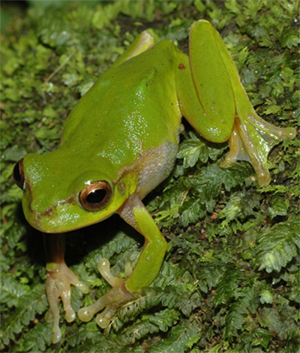




 Mixophyes iteratus (Giant Barred Frog)
Mixophyes iteratus (Giant Barred Frog) 







